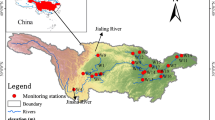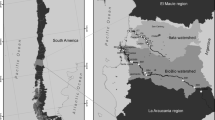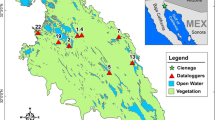Abstract
Due to global change, many wetlands experience water level decreases and changes in their hydrological functioning, modifying their physico-chemical characteristics. Riverine wetlands are particularly complex within this framework because they are supplied by different water sources. This study assessed how long-term water level decreases in riverine wetlands relate to changes in their physico-chemical characteristics (temperature, oxygen, pH, conductivity and nutrient contents: nitrate, ammonium and phosphate). We hypothesized that 1) water level decreases have no effect on water nutrient contents because of the high water renewal by groundwater supplies, which may leach nutrients released from the sediment after the dewatering phase, and 2) the physico-chemical characteristics of the water would become increasingly similar to those of hillslope groundwater due to the increase in their water supplies in wetlands. We compared the surface water physico-chemical characteristics of nine riverine wetlands with contrasting water level decreases between 1993 and 2011. No increase in water nutrient contents occurred. However, depending on the wetland considered, the physico-chemical changes suggested either 1) increased connectivity with hillslope groundwater, 2) a lower rate of water renewal in wetlands or 3) increased river water supplies, potentially related to river lateral migration toward wetlands.




Similar content being viewed by others
References
Acreman MC, Adams B, Birchall P, Connorton B (2000) Does groundwater abstraction cause degradation of rivers and wetlands? Water and Environment Journal 14:200–206
Amoros C, Bornette G (2002) Connectivity and biocomplexity in waterbodies of riverine floodplains. Freshwater Biology 47:761–776
Baldwin DS, Mitchell AM (2000) The effects of drying and re-flooding on the sediment and soil nutrient dynamics of lowland river-floodplain systems. Regulated Rivers: Research & Management 16:457–467
Bornette G, Amoros C (1991) Aquatic vegetation and hydrology of a braided river floodplain. Journal of Vegetation Science 2:497–512
Bornette G, Heiler G (1994) Environmental and biological responses of former channels to river incision: a diachronic study on the upper Rhône river. Regulated Rivers: Research & Management 9:79–92
Bornette G, Amoros C, Collilieux G (1994a) Role of seepage supply in aquatic vegetation dynamics in former river channels - prediction testing using a hydroelectric construction. Environmental Management 18:223–234
Bornette G, Amoros C, Chessel D (1994b) Effect of allogenic processes on successional rates in former river channels. Journal of Vegetation Science 5:237–246
Bornette G, Amoros C, Castella C, Beffy JL (1994c) Succession and fluctuation in the aquatic vegetation of two former Rhône River channels. Vegetatio 110:171–184
Bornette G, Amoros C, Rostan J-C (1996) River incision and vegetation dynamics in cut-off channels. Aquatic Sciences 58:31–51
Bornette G, Amoros C, Piégay H, Tachet J, Hein T (1998) Ecological complexity of wetlands within a river landscape. Biological Conservation 85:35–45
Bornette G, Piégay H, Citterio A, Amoros C, Godreau V (2001) Aquatic plant diversity in four river floodplains: a comparison at two hierarchical levels. Biodiversity and Conservation 10:1683–1701
Bornette G, Tabacchi E, Hupp C, Puijalon S, Rostan J-C (2008) A model of plant strategies in fluvial hydrosystems. Freshwater Biology 53:1692–1705
Bravard J-P, Malavoi JR, Amoros C (1989) L’Ain, ou la difficulté de gérer une rivière en cours de métamorphose. Univ. Jean Moulin. Lyon. Actes de la journée d’étude du 17 mars 1989, Rivières en crise Saône, Ain, Durance; 57–71
Bravard J-P, Amoros C, Pautou G, Bornette G, Bournaud M, Creuzé des Châteliers M, Gibert J, Peiry J-L, Perrin J-F, Tachet H (1997) River incision in south-east France: morphological phenomena and ecological effects. Regulated Rivers: Research & Management 13:75–90
Brinson MM (1993) Changes in the functioning of wetlands along environmental gradients. Wetlands 13:65–74
Brinson MM, Malvàrez AI (2002) Temperate freshwater wetlands: types, status, and threats. Environmental Conservation 29:115–133
Buijse AD, Coops H, Staras M, Jans LH, Van Geest GJ, Grift RE, Ibelings BW, Oosterberg W, Roozen FCJM (2002) Restoration strategies for river floodplains along large lowland rivers in Europe. Freshwater Biology 47:889–907
Bunn SE, Arthington AH (2002) Basic principles and ecological consequences of altered flow regimes for aquatic biodiversity. Environmental Management 30:492–507
Cabezas A, González E, Gallardo B, García M, González M, Comín FA (2008) Effects of hydrological connectivity on the substrate and understory structure of riparian wetlands in the Middle Ero River (NE Spain): implication for restoration and management. Aquatic Sciences 70:361–376
Cabezas A, Garcia M, Gallardo B, Gonzalez E, Gonzalez-Sanchis M, Comin FA (2009) The effect of anthropogenic disturbance on the hydrochemical characteristics of riparian wetlands at the Middle Ebro River (NE Spain). Hydrobiologia 617:101–116
Cavanaugh JC, Richardson WB, Strauss EA, Bartsch LA (2006) Nitrogen dynamics in sediment during water level manipulation on the upper Mississippi river. River Research and Applications 22:651–666
Coe MT (1998) A linked global model of terrestrial hydrologic processes: simulation of modern rivers, lakes, and wetlands. Journal of Geophysical Research 103:8885–8899
Corstanje R, Reddy KR (2004) Response of biogeochemical indicators to a drawdown and subsequent reflood. Journal of Environmental Quality 33:2357–2366
De Groot C-J, Van Wijck C (1993) The impact of desiccation of a freshwater marsh (Garcines Nord, Camargue, France) on sediment-water-vegetation interactions. Part 1: the sediment chemistry. Hydrobiologia 252:83–94
Freeman C, Liska G, Ostle NJ, Lock MA, Reynolds B, Hudson J (1996) Microbial activity and enzymic decomposition processes following peatland water table drawdown. Plant and Soil 180:121–127
Gómez R, Arce MI, Sánchez JJ, del Mar S-MM (2012) The effects of drying on sediment nitrogen content in a Mediterranean intermittent Stream: a microcosm study. Hydrobiologia 679:43–59
IPCC (2001) Climate change 2001: the scientific basis.Contribution of working group I to the third assessment report of the intergovernmental panel on climate change. Houghton JT, Ding Y, Griggs DJ, Noguer M, van der Linden PJ, Dai X, Maskell K, Johnson CA (ed). Cambridge University Press, Cambridge, United Kingdom and New York, NY, USA
James WF, Barko JW, Eakin HL (2004) Impacts of sediment dewatering and rehydration on sediment nitrogen concentration and macrophyte growth. Canadian Journal of Fisheries and Aquatic Sciences 61:538–546
Johnston CA, Bridgham SD, Schubauer-Berigan JP (2001) Nutrient dynamics in relation to geomorphology of riverine wetlands. Soil Science Society of America Journal 65:557–577
Keddy PA, Fraser LH, Solomeshch AI, Junk WJ, Campbell DR, Arroy MTK, Alho CJR (2009) Wet and wonderful: the world’s largest wetlands are conservation priorities. BioScience 59:39–51
Lucassen ECHET, Smolders AJP, Lamers LPM, Roelofs JGM (2005) Water table fluctuations and groundwater supply are important in preventing phosphate-eutrophication in sulphate rich fens: consequences for wetland restoration. Plant and Soil 269:109–115
Marston RA, Girel J, Pautou G, Piégay H, Bravard J-P, Arneson C (1995) Channel metamorphosis, floodplain disturbance, and vegetation development: Ain River, France. Geomorphology 13:121–131
Meyer JL, Sale MJ, Mulholland PJ, Poff NL (1999) Impacts of climate change on aquatic ecosystem functioning and health. Journal of the American Water Resources Association 35:1373–1386
Millennium Ecosystem Assessment (2005) Ecosystems and human well-being: wetlands and water synthesis. World resource institute, Washington DC
Olde Venterink HO, Davidson TE, Kiehl K, Leonardson L (2002) Impact of drying and re-wetting on N, P and K dynamics in a wetland soil. Plant and Soil 119:119–130
Olila OG, Reddy KR, Stites DL (1997) Influence of draining on soil phosphorus forms and distribution in a constructed wetland. Ecological Engineering 9:157–169
Piégay H, Bornette G, Citterio A, Hérouin E, Moulin B, Statiotis C (2000) Channel instability as a control on silting dynamics and vegetation patterns within perifluvial aquatic zones. Hydrological Processes 14:3011–3029
Puijalon S, Bornette G (2004) Morphological variation of two taxonomically distant plant species along a natural flow velocity gradient. New Phytologist 163:651–660
Racchetti E, Bartoli M, Soana E, Longhi D, Christian RR, Pinardi M, Viaroli P (2011) Influence of hydrological connectivity of riverine wetlands on nitrogen removal via denitrifcation. Biogeochemistry 103:335–354
RAMSAR (2002) Les zones humides, valeurs et fonctions. Suisse, Gland
R-Development-Core-Team (2009) R: A Language and Environment for Statistical Computing. from http://www.r-project.org.In
Rollet AJ, Piégay H, Dufour S, Bornette G, Persat H (2014) Assesment of consequences of sediment deficit on a gravel river bed downstream of dmas in restoration perspectives: application of a multicriteria, hierarchical and spatially explicit diagnonsis. River Res Appl 30:939–953
Smolders AJP, Moonen M, Zwaga K, Lucassen ECHET, Lamers LPM, Roelofs JGM (2006) Changes in pore water chemistry of dessicating freshwater sediments with different sulphur content. Geoderma 132:372–383
Song K-Y, Zoh K-D, Kang H (2007) Release of phosphate in a wetland by changes in hydrological regime. Science of the Total Environment 380:13–18
Thioulouse J, Chessel D, Dolédec S, Olivier M-J (1997) ADE-4: a multivariate analysis and graphical display software. Statistics and Computing 7:75–83
Thoms MC (2006) Variability in riverine ecosystems. River Research and Applications 22:115–121
Tockner K, Pennetzdorfer D, Reiner N, Schiemer F, Ward JV (1999) Hydrological connectivity, and the exchange of organic matter and nutrients in a dynamic river-floodplain system (Danube, Austria). Freshwater Biology 41:521–535
van Diggelen R, Middleton B, Bakker J, Grootjans AP, Wassen M (2006) Fens and floodplains of the temperate zone: present status, threats, conservation and restoration. Applied Vegetation Science 9:157–162
Winter TC (1999) Relation of streams, lakes, and wetlands to groundwater flow systems. Hydrogeology Journal 7:28–45
Acknowledgments
This work was performed under the aegis of the LTER “Zone Atelier Bassin du Rhône” and was funded by the Wetchange Program (ANR-09-CEP-006-01) of the French National Research Agency (Agence Nationale de la Recherche-ANR).
Author information
Authors and Affiliations
Corresponding author
Rights and permissions
About this article
Cite this article
De Wilde, M., Puijalon, S., Vallier, F. et al. Physico-Chemical Consequences of Water-Level Decreases in Wetlands. Wetlands 35, 683–694 (2015). https://doi.org/10.1007/s13157-015-0658-y
Received:
Accepted:
Published:
Issue Date:
DOI: https://doi.org/10.1007/s13157-015-0658-y




